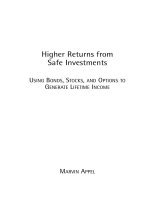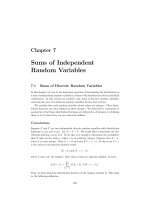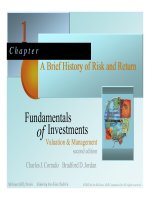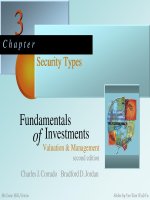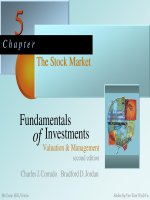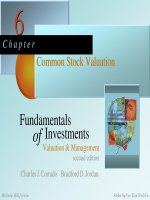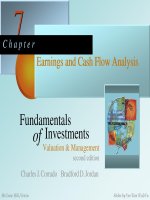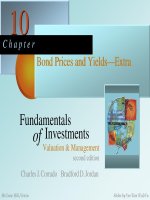Charles J. Corrado_Fundamentals of Investments - Chapter 7 pptx
Bạn đang xem bản rút gọn của tài liệu. Xem và tải ngay bản đầy đủ của tài liệu tại đây (295.68 KB, 48 trang )
CHAPTER 7
Earnings and Cash Flow Analysis
Cash flow is a company’s lifeblood, and for a healthy company the primary
source of cash flow is earnings. Little wonder that security analysts are
obsessed with both. Their goal is to predict future earnings and cash flow. An
analyst who predicts well has a head start in knowing which stocks will go up
and which stocks will go down.
In the previous chapter, we examined some important concepts of stock analysis and
valuation. Here, we probe deeper into the topic of common stock valuation through an analysis of
earnings and cash flow. In particular, we focus on earnings and cash flow forecasting. This chapter,
will acquaint you with financial accounting concepts necessary to understand basic financial
statements and perform earnings and cash flow analysis using these financial statements. You may
not become an expert analyst yet - this requires experience. But you will have a grasp of the
fundamentals, which is a good start.
Unfortunately, most investors have difficulty reading financial statements and instead rely on
various secondary sources of financial information. Of course, this is good for those involved with
publishing secondary financial information. Bear in mind, however, that no one is paid well just for
reading such sources of financial information. By reading this chapter, you take an important step
toward becoming financial-statement literate, and an extra course in financial accounting is also
helpful. But ultimately you learn to read financial statements by reading financial statements! Like a
good game of golf or tennis, financial-statement reading skills require practice. If you have an
2 Chapter 7
aptitude for it, financial statement analysis is a skill worth mastering. Good analysts are paid well, but
good analysis is expected in return. Maybe you too can become one of the few, the proud - a financial
analyst.
7.1 Sources of Financial Information
Good financial analysis begins with good financial information. An excellent primary source
of financial information about any company is its annual report to stockholders. Most companies
expend considerable resources preparing and distributing annual reports. In addition to their
stockholders, companies also make annual reports available to anyone requesting a copy. A
convenient way to request copies of annual reports from several companies simultaneously is to use
the annual reports service provided by the Wall Street Journal. If you open the Journal to its daily
stock price reports, you will see a shamrock symbol next to entries for many individual stocks. The
shamrock indicates that the company will send annual reports to readers through the Wall Street
Journal. Requests can be submitted by telephone or by fax.
The Internet is a convenient source of financial information about many companies. For
example, the New York Stock Exchange website (www.nyse.com) provides a directory of websites
for companies whose stock trades on the exchange. The content of company websites varies greatly,
but many provide recent quarterly or annual financial reports.
In addition to company annual reports, a wealth of primary financial information is available
to investors through the Securities and Exchange Commission. The SEC requires corporations with
publicly traded securities to prepare and submit financial statements on a regular basis. When
received, these documents are made available for immediate public access through the SEC’s
Earnings/Cash Flow Analysis 3
Electronic Data Gathering and Retrieval (EDGAR) archives. The EDGAR archives are accessible
free of charge through the Internet (www.sec.gov) and are an excellent source of timely financial
information.
(marg. def. 10K Annual company report filed with the SEC). 10Q Quarterly updates
of 10K filed with SEC. EDGAR Electronic archive of company filings with the SEC.)
The most important EDGAR document is the annual 10K report, often simply called the
"10K." Companies are required to submit an EDGAR-compatible 10K file to the SEC at the end of
each fiscal year. They are also required to file quarterly updates, called 10Qs. The 10Q is a mini-10K
filed each quarter, except when the 10K is filed. Every 10K and 10Q report contains three important
financial statements: a balance sheet, an income statement, and a cash flow statement. You must be
familiar with these three financial statements to analyze company earnings and cash flow.
(marg. def. balance sheet Accounting statement that provides a snapshot view of a
company’s assets and liabilities on a particular date.)
(marg. def. income statement Summary statement of a firm’s revenue and cash flow
over a specific accounting period, usually a quarter or a year.)
(marg. def. cash flow statement Analysis of a firm’s sources and uses of cash over
the accounting period, summarizing operating, investing, and financing cash flows.)
7.2 Financial Statements
Financial statements reveal the hard facts about a company’s operating and financial
performance. This is why the SEC requires timely dissemination of financial statements to the public.
It’s also why security analysts spend considerable time poring over a firm’s financial statements
before making an investment recommendation. A firm’s balance sheet, the income statement, and cash
flow statement are essential reading for security analysts. Each of these interrelated statements offers
4 Chapter 7
a distinct perspective. The balance sheet provides a snapshot view of a company’s assets and liabilities
on a particular date. The income statement measures operating performance over an accounting
period, usually a quarter or a year, and summarizes company revenues and expenses. The cash flow
statement reports how cash was generated and where it was used over the accounting period.
Understanding the format and contents of these three financial statements is a prerequisite for
understanding earnings and cash flow analysis.
We begin by considering the basic structure and general format of financial statements through
a descriptive analysis of the balance sheet, income statement, and cash flow statement of a
hypothetical intergalactic company - the Borg Corporation.
(marg. def. asset Anything a company owns that has value. liability A firm's financial
obligations. equity An ownership interest in the company.)
7.2a The Balance Sheet
Figure 7.1 presents year-end 2535 and 2536 balance sheets for Borg Corporation. The format
of these balance sheets is typical of that contained in company annual reports distributed to
stockholders and 10K filings with the SEC. Get used to the accounting practice of specifying
subtraction with parentheses and calculating subtotals while moving down a column of numbers. For
example, Borg's 2536 fixed assets section is reproduced below, with the left numerical column
following standard accounting notation and the right numerical column follows standard arithmetic
notation.
Earnings/Cash Flow Analysis 5
Fixed Assets: Accounting style Numeric style
Plant Facilities $35,000 $35,000
Production Equipment 20,000 +20,000
Administrative Facilities 15,000 +15,000
Patents 10,000 +10,000
Accumulated Depreciation (20,000)
20,000
Total Fixed Assets $60,000 $60,000
Common to both numerical columns, an underline indicates that the numbers listed above should be
summed. However, accounting notation omits the plus "+" sign and subtraction is indicated by
parentheses "( )" instead of the more familiar minus "" sign. Referring back to Figure 7.1, notice that
total fixed assets is a subtotal used to calculate total assets, which is indicated by a double underline.
With these conventions in mind, let us look over these sample balance sheets and try to become
familiar with their format and contents.
6 Chapter 7
Figure 7.1 Borg Corporation Balance Sheets, 2535 and 2536
Year 2536 Year 2535
Current assets:
Cash $2,000 $1,356
Accounts receivable $1,200 $1,200
Prepaid expenses $500 $500
Materials & supplies $300 $300
Inventory $6,000
$6,000
Total current assets $10,000 $9,356
Fixed assets:
Plant facilities $35,000 $35,000
Production equipment $20,000 $20,000
Administrative facilities $15,000 $15,000
Patents $10,000 $10,000
Accumulated depreciation ($20,000)
($17,000)
Total fixed assets $60,000 $63,000
Investments:
Cardassian Mining
7% Preferred stock $10,000 $10,000
Klingon Enterprises
Common stock $10,000
Goodwill $5,000
Total investments $25,000 $10,000
Other assets $5,000
$5,000
Total assets $100,000 $87,356
Current liabilities:
Short-term debt $10,000 $10,000
Accounts payable $2,000 $2,000
Leasing obligations $3,000
$3,000
Total current liabilities $15,000 $15,000
Long-term debt $30,000 $20,000
Other liabilities $5,000
$5,000
Total liabilities $50,000 $40,000
Stockholder equity:
Paid-in capital $10,000 $10,000
Retained earnings $40,000
$37,356
Total stockholder equity $50,000 $47,356
Total liabilities and equity $100,000 $87,356
Shares outstanding 2,000 2,000
Year-end stock price $40 $36
Earnings/Cash Flow Analysis 7
The Borg Corporation balance sheet has four major asset categories: current assets, fixed
assets, investments, and other assets. Current assets are cash or items that will be converted to cash
or be used within a year. For example, inventory will be sold, accounts receivable will be collected,
and materials and supplies will be used within a year. Cash is, or course, the quintessential current
asset. Fixed assets have an expected life longer than one year and are used in normal business
operations. Fixed assets may be tangible or intangible. Property, plant, and equipment are the most
common tangible fixed assets. Rights, patents, and licenses are common intangible assets. Except for
land, all fixed assets normally depreciate in value over time. Investments include various securities
held for investment purposes. Goodwill measures the premium paid over market value to acquire an
asset. For example, a company may pay $50 per share for stock with a market price of $40 per share
when acquiring a very large block of stock. Other assets include miscellaneous items not readily
fitting into any of the other asset categories. The sum of these four categories of assets is the firm’s
total assets
The Borg balance sheet has three major liability categories: current liabilities, long-term debt,
and other liabilities. Current liabilities normally require payment or other action within a one-year
period. These include accounts payable and accrued taxes. Long-term debt includes notes, bonds, or
other loans with a maturity longer than one year. Other liabilities include miscellaneous items not
belonging to any other liability category. Stockholder equity is the difference between total assets and
total liabilities. It includes paid-in capital, which is the amount received by the company from issuing
common stock, and retained earnings, which represent accumulated income not paid out as dividends
but instead used to finance company growth.
8 Chapter 7
A fundamental accounting identity for balance sheets states that assets are equal to liabilities
plus equity:
Assets = Liabilities + Equity. [1]
This identity implies that the balance sheet always “balances” because the left side is always equal in
value to the right side. If an imbalance occurs when a balance sheet is created, then an accounting
error has been made and needs to be corrected.
Financial analysts often find it useful to condense a balance sheet down to its principal
categories. This has the desirable effect of simplifying further analysis while still revealing the basic
structure of the company’s assets and liabilities. How much a balance sheet can be condensed and still
be useful is a subjective judgment of the analyst. When making this decision, recall Albert Einstein's
famous dictum: "Simplify as much as possible, but no more."
Figure 7.2 Borg Corporation Condensed Balance Sheet
Cash $2,000 Current liabilities $15,000
Operating assets $8,000 Long-term debt $30,000
Fixed assets $60,000 Other liabilities $5,000
Investments $25,000
Other assets $5,000
Stockholder equity $50,000
Total assets $100,000 Total liabilities and equity $100,000
Figure 7.2 is a condensed version of Borg’s balance sheet that still preserves its basic
structure. Notice that current assets are reduced to two components, cash and operating assets. We
separate cash from operating assets for a good reason. Later, we show that net cash flow from the
cash flow statement is used to adjust cash on the balance sheet. This adjustment is more clearly
illustrated by first separating current assets into cash and operating assets.
Earnings/Cash Flow Analysis 9
CHECK THIS
7.2a What are some examples of current assets?
7.2b. What are some examples of fixed assets?
7.2c. What are some examples of current liabilities?
7.2d. Which accounts in Figure 7.1 show changes between 2535 and 2536 balance sheets?
Figure 7.3 Borg Corporation Condensed Income Statement
Net sales $90,000 $90,000
Cost of goods sold (70,000)
70,000
Gross profit $20,000 $20,000
Operating expenses (13,000)
13,000
Operating income $7,000 $7,000
Investment income 700 +700
Interest expense (2,000)
2,000
Pretax income $5,700 $5,700
Income taxes
1
(2,056)
2,056
Net income $3,644 $3,644
Dividends (1,000) 1,000
Retained earnings $2,644 $2,644
1. A tax rate of 40 percent applies to the total of Operating Income less Interest
Expense plus the taxable 20% portion of preferred stock dividends, i.e., $7,000 -
$2,000 + 20% × 7% × $10,000 = $5,140 and 40% × $5,140 = $2,056.
(marg. def. net income The difference between a company's revenues and expenses,
used to either pay dividends to stockholders or kept as retained earnings within the
company to finance future growth.)
7.2b The Income Statement
Figure 7.3 is a condensed income statement for Borg Corporation. The left column follows
standard accounting notation and the right column follows familiar arithmetic notation. Of course,
the right column would not appear in an actual financial statement and is included here for
10 Chapter 7
1
Actually, the exclusion is either 70 or 80 percent depending on how much of another
company’s stock is held.
convenience only. This income statement reports revenues and expenses for the corporation over a
one-year accounting period. Examine it carefully and be sure you are familiar with its top-down
structure.
The income statement begins with net sales, from which cost of goods sold (COGS) is
subtracted to yield gross profit. Cost of goods sold represents direct costs of production and sales;
that is, costs that vary directly with the level of production and sales. Next, operating expenses are
subtracted from gross profit to yield operating income. Operating expenses are indirect costs of
administration and marketing; that is, costs that do not vary directly with production and sales.
In addition to operating income from its own business operations, Borg Corporation has
investment income from preferred stock dividends. Adding this investment income and then
subtracting interest expense on debt yields pretax income. Finally, subtracting income taxes from
pretax income yields net income. Net income is often referred to as the “bottom line” because it is
normally the last line of the income statement. In this example, however, we have added dividends
and retained earnings information, items that often appear in a separate financial statement. To avoid
a separate statement, we here show that Borg Corporation paid dividends during the year. The sum
of dividends and retained earnings is equal to net income:
Net Income = Dividends + Retained Earnings. [2]
The footnote to Figure 7.3 explains that only 20 percent of preferred stock dividends are
taxable. This feature of the federation tax code allows a company to exclude 80 percent of dividends
received from another company from federal income tax.
1
In this case, Borg receives $700 in
Earnings/Cash Flow Analysis 11
dividends from Cardassian Mining and pays taxes on only $140 (20 percent) of this amount.
Assuming a 40 percent tax rate, the actual tax amount is $56 = 40% × $140.
CHECK THIS
7.2e. What is cost of goods sold (COGS)?
7.2f. What is the difference between gross profit and operating income?
7.2g. What is the difference between net income and pretax income?
7.2h. What is meant by retained earnings?
(marg. def. cash flow Income realized in cash form.)
(marg. def. noncash items Income and expense items not realized in cash form.)
7.2c The Cash Flow Statement
The cash flow statement reports where a company generated cash and where cash was used
over a specific accounting period. The cash flow statement assigns all cash flows to one of three
categories: operating cash flows, investment cash flows, or financing cash flows.
Figure 7.4 Borg Corporation Condensed Cash Flow Statement
Net Income $3,644 $3,644
Depreciation 3,000
+3,000
Operating Cash Flow $6,644 $6,644
Investment Cash Flow
1
($15,000) 15,000
Financing Cash Flow
2
$9,000
+9,000
Net Cash Increase $644 $644
1. December 2536 purchase of 50 percent interest in Klingon Enterprises for $15,000
(including $5,000 goodwill).
2. Issue of $10,000 par value 8 percent coupon bonds, less a $1,000 dividend payout.
12 Chapter 7
Figure 7.4 is a condensed cash flow statement for Borg Corporation. (This is the last
appearance of both accounting and arithmetic notation.) The cash flow statement begins with net
income, which is the principal accounting measure of earnings for a corporation. However, net
income and cash flow are not the same and often deviate greatly from each other. A primary reason
why income differs from cash flow is that income contains noncash items. For example, depreciation
is a noncash expense that must be added to net income when calculating cash flow. Adjusting net
income for noncash items yields operating cash flow.
(marg. def. operating cash flow Cash generated by a firm’s normal business
operations.)
(marg. def. investment cash flow Cash flow resulting from purchases and sales of
fixed assets and investments.)
(marg. def. financing cash flow Cash flow originating from the issuance or
repurchase of securities and the payment of dividends.)
Operating cash flow is the first of three cash flow categories reported in the cash flow
statement. The second and third categories are investment cash flow and financing cash flow.
Investment cash flow includes any purchases or sales of fixed assets and investments. For example,
Borg's purchase of Klingon Enterprises common stock reported in footnote 1 is an investment cash
flow. Financing cash flow includes any funds raised by an issuance of securities or expended by a
repurchase of outstanding securities. In this example, Borg’s $10,000 debt issue and $1,000 dividend
payout reported in footnote 2 are examples of financing cash flows.
Standard accounting practice specifies that dividend payments to stockholders are financing
cash flows, whereas interest payments to bondholders are operating cash flows. One reason is that
dividend payments are discretionary, while interest payments are mandatory. Also, interest payments
Earnings/Cash Flow Analysis 13
are tax-deductible expenses, but dividend payouts are not tax deductible. In any case, interest
payments are cash expenses reported on the income statement. Since they are cash expenses, they do
not appear in the cash flow statement to reconcile the difference between income and cash flow.
The sum of operating cash flow, investment cash flow, and financing cash flow yields the net
change in the firm’s cash. This change is the “bottom line” of the cash flow statement and reveals how
much cash flowed into or out of the company’s cash account during an accounting period.
CHECK THIS
7.2i. What is the difference between net income and operating cash flow?
7.2j. What are some noncash items used to calculate operating cash flow?
7.2k. What is the difference between an investment cash flow and a financing cash flow?
7.2l. What is meant by net increase in cash?
7.2m. Can you explain why a cash item like interest expense does not appear on the cash flow
statement?
14 Chapter 7
(marg. def. return on assets (ROA) Net income stated as a percentage of total
income.)
(marg. def. return on equity (ROE) Net income stated as a percentage of
stockholder equity.)
7.2d Performance Ratios and Price Ratios
Annual reports and 10Ks normally contain various items of supplemental information about
the company. For example, certain profitability ratios may be reported to assist interpretation of the
company's operating efficiency. For Borg Corporation, some standard profitability ratios are
calculated as follows.
Ratio Formula Calculation
Gross margin Gross profit / Net sales $20,000 / $90,000
= 22.2%
Operating margin Operating income / Net sales $7,000 / $90,000
= 7.8%
Return on assets (ROA) Net income / Total assets $3,644 / $100,000
= 3.64%
Return on equity (ROE) Net income / Stockholder equity $3,644 / $50,000
= 7.29%
Notice that return on assets (ROA) and return on equity (ROE) are calculated using current year-
end values for total assets and stockholder equity. It could be argued that prior-year values should
be used for these calculations. However, standard practice calls for the use of current year-end values.
Annual reports and 10Ks may also report per-share calculations of book value, earnings, and
operating cash flow, respectively. Per-share calculations require the number of common stock shares
Earnings/Cash Flow Analysis 15
outstanding. Borg's balance sheet reports 2,000 shares of common stock outstanding. Thus for Borg
Corporation, these per-share values are calculated as follows.
Ratio Formula Calculation
Book value per share
(BVPS)
Stockholder equity /
Shares outstanding
$50,000 / 2,000
= $25
Earnings per share
(EPS)
Net income /
Shares outstanding
$3,644 / 2,000
= $1.82
Cash flow per share
(CFPS)
Operating cash flow /
Shares outstanding
$6,644 / 2,000
= $3.32
Notice that cash flow per share (CFPS) is calculated using operating cash flow - NOT the bottom line
on the cash flow statement! Most of the time when you hear the term "cash flow," it refers to
operating cash flow.
Recall that in the previous chapter, we made extensive use of price ratios to analyze stock
values. Using per-share values calculated immediately above, and Borg's year-end stock price of $40
per share, we get the following price ratios:
Ratio Formula Calculation
Price-book
(P/B)
Stock price / BVPS $40 / $25 = 1.6
Price-earnings
(P/E)
Stock price / EPS $40 / $1.82 = 22
Price-cash flow
(P/CF)
Stock price / CFPS $40 / $3.32 = 12
We use these price ratios later when assessing the potential impact of a sales campaign on Borg
Corporation's future stock price.
16 Chapter 7
CHECK THIS
7.2n. What is the difference between gross margin and operating margin?
7.2m. What is the difference between return on assets (ROA) and return on equity (ROE)?
7.2o. What is the difference between earnings per share (EPS) and cash flow per share (CFPS)?
7.2p. How is cash flow per share (CFPS) calculated?
(marg. def. pro forma financial statements Statements prepared using certain
assumptions about future income, cash flow, and other items. Pro forma literally
means according to prescribed form.)
7.3 Financial Statement Forecasting
In December 2536, Borg publicly announced the completed acquisition of a 50 percent
financial interest in Ferengi Traders. However, half the acquired shares do not carry voting rights, so
the acquisition is treated as a simple investment on the balance sheet. The stated purpose of the
acquisition was to expand sales outlets. Complementing the acquisition, Borg also announced plans
for a marketing campaign to increase next year’s net sales to a targeted $120,000. As a Borg analyst,
you must examine the potential impact of these actions. You immediately contact Borg management
to inquire about the details of the acquisition and the marketing campaign. Armed with this additional
information, you decide to construct pro forma financial statements for Borg Corporation for the year
2537. You also decide to formulate your analysis by considering two scenarios: an optimistic sales
scenario and a pessimistic sales scenario. Under the optimistic scenario, the marketing campaign is
successful and targeted Net Sales of $120,000 are realized with an assumed cost of goods sold of
$90,000. Under the pessimistic scenario, only $100,000 of net sales are realized with a cost of goods
sold of $80,000. Operating expenses will be $17,000 under both scenarios, reflecting the costs of the
Earnings/Cash Flow Analysis 17
marketing campaign. The appropriate sequence for your analysis is to construct pro forma income
statements, then pro forma cash flow statements, followed by pro forma balance sheets.
Figure 7.5 Borg Corp. Pro Forma Income Statements
Scenario: Optimistic Pessimistic
Net Sales $120,000 $100,000
Cost of Goods Sold (90,000)
(80,000)
Gross Profit $30,000 $20,000
Operating Expenses (17,000)
(17,000)
Operating Income $13,000 $3,000
Investment Income
1
2,200 700
Interest Expense
2
(2,800) (2,800)
Pretax Income $12,400 $900
Income Taxes
3
(4,136)
(136)
Net Income $8,264 $764
Dividends
4
$1,000 $1,000
Retained Earnings $7,264 ($236)
1. Preferred stock dividends of $700 plus $1,500 investment income from Ferengi
Traders under optimistic sales results and $0 under pessimistic sales results, i.e.,
$700 + $1,500 = $2,200.
2. Prior-year interest expense of $2,000 plus payment of 8 percent coupons on the
December 2536 debt issue of $10,000, i.e., $2,000 + 8% × $10,000 = $2,800.
3. Tax rate of 40 percent applied to the sum of Operating Income less Interest
Expense plus the 20% taxable portion of preferred stock dividends, i.e., ($13,000 -
$2,800 + 20% × 7% × $10,000) × 40% = $4,136.
4. Assumes no change in dividends from prior year.
7.3a The Pro Forma Income Statement
Figure 7.5 contains side-by-side pro forma income statements for Borg Corporation
corresponding to optimistic and pessimistic sales scenarios in the coming year. These begin with the
assumed net sales and cost of goods sold values for both scenarios. They then proceed with the
standard top-down calculations of income where several calculation methods and additional
18 Chapter 7
assumptions are explained in footnotes. The optimistic sales scenario produces a net income of
$8,264, of which $1,000 is paid as dividends and $7,264 is kept as retained earnings. Under the
pessimistic sales scenario net income is only $764, with $1,000 of dividends and -$236 of retained
earnings.
Footnote 1 explains that investment income is $2,200 under optimistic sales and $700 under
pessimistic sales. This reflects constant preferred stock dividends of $700 and assumed noncash
investment income from Ferengi Traders of $1,500 under optimistic sales and $0 under pessimistic
sales. The difference in scenario investment incomes stems from the fact that Ferengi is involved with
the sales campaign.
Footnote 3 explains that taxes are paid on operating income less interest expense plus the
taxable portion of preferred stock dividends. Notice that Borg's noncash investment income from
Ferengi Traders is not taxed because Ferengi paid no dividends. In this situation, Borg records the
value of its investment in Ferengi as its share of Ferengi's stockholder equity value. Thus when
Ferengi adds retained earnings to its equity value, Borg records its share of the addition as noncash
income and changes the balance sheet value of its investment in Ferengi accordingly. The next step
of your analysis is construction of pro forma cash flow statements.
CHECK THIS
7.3a. Create a pro forma income statement for Borg Corporation corresponding to pessimistic sales
results assuming noncash investment losses of $1,000.
Earnings/Cash Flow Analysis 19
Figure 7.6 Borg Corp. Pro Forma Cash Flow Statements
Scenario: Optimistic Pessimistic
Net income $8,264 $764
Depreciation/amortization
1
3,200 3,200
Increase in operating assets
2
(2,000) (3,000)
Noncash investment income (1,500)
(0)
Operating cash flow $7,964 $964
Investment cash flow
3
$0 $0
Financing cash flow
4
($1,000) ($1,000)
Net cash increase $6,964 ($36)
1. Assumes the same $3,000 depreciation as in the prior year and annual goodwill
amortization of $200 based on a 25-year amortization schedule.
2. Assumes an increase in operating assets of $2,000 under optimistic sales and
$3,000 under pessimistic sales.
3. Assumes no new investments.
4. Assumes no change in dividend payouts.
7.3b The Pro Forma Cash Flow Statement
Figure 7.6 contains side-by-side pro forma cash flow statements for Borg Corporation under
optimistic and pessimistic sales scenarios. Under the optimistic sales scenario net cash increase is
$6,964; under the pessimistic scenario net cash flow is -$36. The net cash increase is applied to adjust
the cash account on the pro forma balance sheet. This adjustment is now more convenient since you
separated cash from operating assets in Borg's condensed balance sheet.
Footnote 1 explains that goodwill amortization is $200 per year based on a 25-year
amortization schedule. This amortization is applied to the $5,000 of goodwill on Borg's prior-year
balance sheet associated with its purchase of a 50 percent stake in Ferengi Traders. Footnote 2
explains that operating assets are assumed to increase by $2,000 under optimistic sales and $3,000
under pessimistic sales. These increases are realistic since a sales campaign will surely require
20 Chapter 7
additional inventory. The increase is bigger under pessimistic sales because more inventory goes
unslod. Your next step is to create the pro forma balance sheet for Borg Corporation.
CHECK THIS
7.3b. Create a pro forma cash flow statement for Borg Corporation under pessimistic sales results
assuming noncash investment losses of $1,000.
Figure 7.7 Borg Corporation Pro Forma Balance Sheets
Scenario: Optimistic Pessimistic
Cash
1
$8,964 $1,964
Operating assets
2
10,000 11,000
Fixed assets
3
57,000 57,000
Investments
4
26,300 24,800
Other assets 5,000
5,000
Total assets $107,264 $99,764
Current liabilities $15,000 $15,000
Long-term debt 30,000 30,000
Other liabilities 5,000 5,000
Stockholder equity
5
57,264
49,764
Total liabilities and equity $107,264 $99,764
1. Prior-year cash of $2,000 plus $6,964 net cash flow from the pro forma cash flow
statement.
2. Prior-year operating assets of $8,000 plus an additional $2,000 under optimistic sales and
$3,000 under pessimistic sales.
3. Prior-year fixed assets of $60,000 less the assumed $3,000 depreciation.
4. Prior-year investments of $25,000 plus noncash investment income of $1,500 under
optimistic sales only less $200 goodwill amortization.
5. Prior-year equity of $50,000 plus $7,264 retained earnings from the pro forma income
statement.
Earnings/Cash Flow Analysis 21
7.3c The Pro Forma Balance Sheet
Figure 7.7 contains side-by-side pro forma balance sheets for Borg Corporation as they might
result from optimistic and pessimistic sales scenarios. This balance sheet is created by starting with
the prior-year condensed balance sheet and then making the following adjustments consistent with
the pro forma income statements and cash flow statements.
1. Cash of $2,000 is adjusted by net cash increase of $6,964 under the optimistic sales
scenario and -$36 under the pessimistic sales scenario.
2. Current assets of $8,000 are increased by $2,000 under the optimistic sales scenario
and increased by $3,000 under the pessimistic sales scenario.
3. Fixed assets of $60,000 are adjusted by depreciation of $3,000, which is the same
under both sales scenarios.
4. Investments of $25,000 are increased by the assumed noncash investment income
from Ferengi Traders of $1,500 under optimistic sales and $0 under pessimistic sales,
less $200 of goodwill amortization. As noted earlier, the difference by scenario is
based on the fact that Ferengi is involved with the sales campaign.
5. Equity of $50,000 is adjusted for retained earnings of $7,264 under optimistic sales
and -$236 under pessimistic sales.
All other accounts remain unchanged, which is a simplifying assumption made to focus attention on
the immediate impact of the sales campaign.
CHECK THIS
7.3c. Create a pro forma balance sheet for Borg under a pessimistic sales scenario assuming
noncash investment losses of $1,000.
22 Chapter 7
7.3d Projected Profitability and Price Ratios
In addition to preparing pro forma financial statements, you decide to also calculate projected
profitability ratios and per-share values under optimistic and pessimistic sales scenarios. These are
reported immediately below and compared with their original year-end values.
Scenario Original Optimistic Pessimistic
Gross margin 22.22% 25% 20%
Operating margin 7.78% 10.83% 3%
Return on assets (ROA) 3.64% 7.70% .7%
Return on equity (ROE) 7.29% 14.43% 1.54%
Book value per share (BVPS) $25 $28.63 $24.88
Earnings per share (EPS) $1.82 $4.13 $0.38
Cash flow per share (CFPS) $3.32 $3.98 $.48
One common method of analysis is to calculate projected stock prices under optimistic and
pessimistic sales scenarios using prior-period price ratios and projected per-share values from pro
forma financial statements. Similar procedures were performed in the previous chapter using prior-
period average price ratios and per-share values based on growth rate projections. For Borg
Corporation, you decide to take year-end 2536 price ratios and multiply each ratio by its
corresponding pro forma per-share value. The results of these projected stock price calculations are
shown immediately below.
Earnings/Cash Flow Analysis 23
Projected stock prices
Scenario Optimistic Pessimistic
BVPS × P/B $45.81 $39.81
EPS × P/E $90.86 $8.36
CFPS × P/CF $47.76 $5.76
These projected stock prices reflect widely varying degrees of sensitivity to optimistic and pessimistic
sales scenario outcomes. For example, projected prices based on EPS and CFPS are especially
sensitive to which scenario is realized. On the other hand, projected stock prices based on BVPS are
far less sensitive to scenario realization.
Which projected stock price is correct? Well, it clearly depends on which sales scenario is
realized and which price ratio the financial markets will actually use to value Borg Corporation's
stock. This is where experience and breadth of knowledge count immensely. Of course no one can
make perfectly accurate predictions, but the analyst's job is to expertly assess the situation and make
an investment recommendation supported by reasonable facts and investigation. But some analysts
are better than others. Like professional baseball players, professional stock analysts with better
batting averages can do well financially.
7.4 Adolph Coors Company Case Study
After carefully reading the analysis of Borg Corporation, you should have a reasonably clear
picture of how earnings and cash flow analyses might proceed using pro forma financial statements.
To further illustrate the use of pro forma financial statements in earnings and cash flow analysis, this
24 Chapter 7
section presents an analysis based on the 1995 financial statements for Adolph Coors Company.
Using data for a real company provides a real challenge (You didn’t believe Borg was real?).
This section begins with a review of Coors 1995 financial statements. We then proceed to
analyze the effects on earnings and cash flow that might result from product sales either rising or
falling by 10 percent. The analysis is similar to that for Borg Corporation, but there are a few
important differences. Amounts shown are in thousands of dollars (except earnings per share).
Figure 7.8 Adolph Coors Company 1995 Balance Sheet
Cash and cash equivalents $32,386
Operating assets 330,134
Property, plant, equipment 887,409
Goodwill 26,470
Other assets 110,458
Total assets $1,386,857
Current liabilities $323,663
Long-term debt 195,000
Other liabilities 173,178
Total liabilities $691,841
Paid-in capital $43,726
Retained earnings 651,290
Total shareholder equity $695,016
Total liabilities and equity $1,386,857
Earnings/Cash Flow Analysis 25
Figure 7.9 Adolph Coors Company 1995 Income Statement
Net sales $1,675,379
Cost of goods sold (1,091,763)
Gross profit $583,616
Operating expenses (503,688)
Operating income $79,928
Other income 3,868
Net interest expense (10,518)
Pretax income $73,278
Income tax 30,100
Net income $43,178
Earnings per share $1.13
Shares outstanding 38,170
Figure 7.10 Adolph Coors Company 1995 Cash Flow Statement
Net income $43,178
Depreciation and amortization 122,830
Loss on Sale of properties 1,274
Change in deferred taxes (1,744)
Changes in operating assets (19,122)
Changes in current liabilities (56,319)
Operating cash flow $90,097
Net additions to properties ($101,349)
Changes in other assets (14,823)
Investing cash flow ($116,172)
Issuance/redemption of long-term debt $56,000
Issuance/purchase of stock (5,819)
Dividends paid (19,066)
Other financing (116)
Financing cash flow $30,999
Net cash increase $4,924
Net cash increase after foreign
currency translation adjustment $5,218
